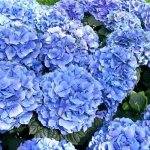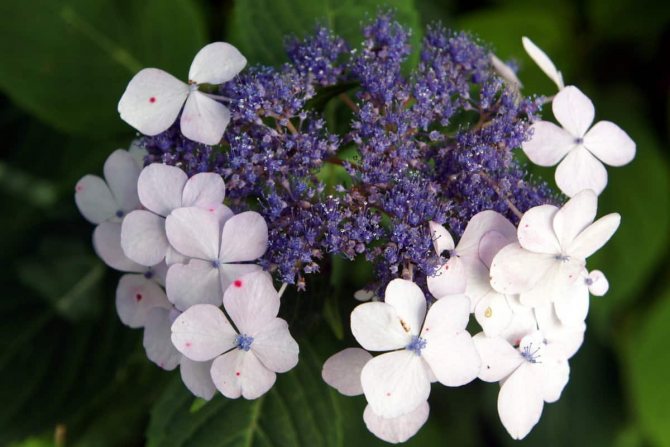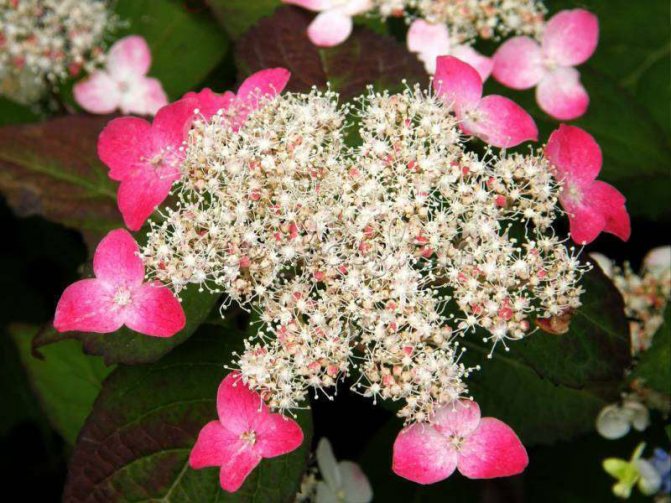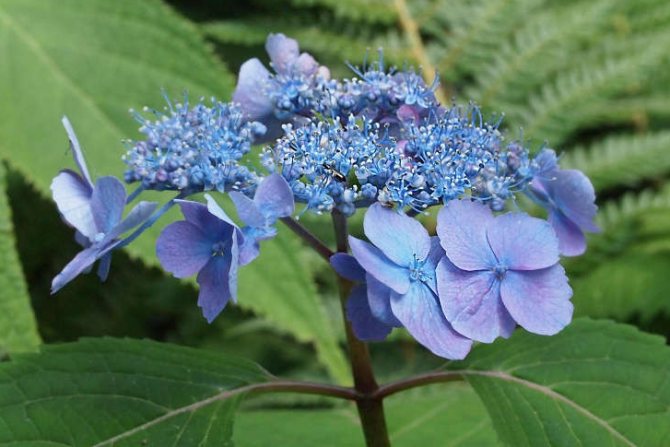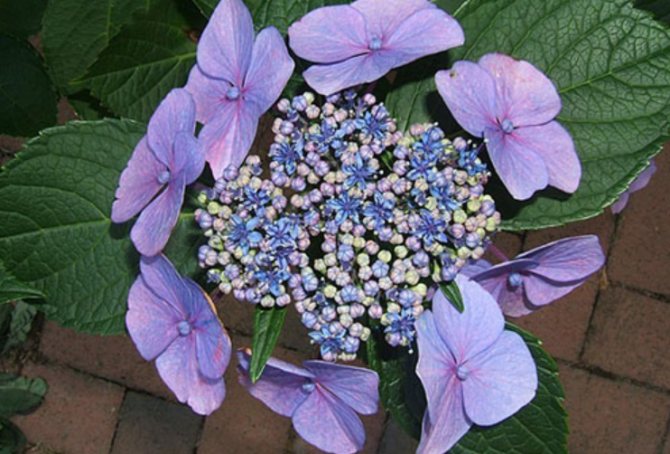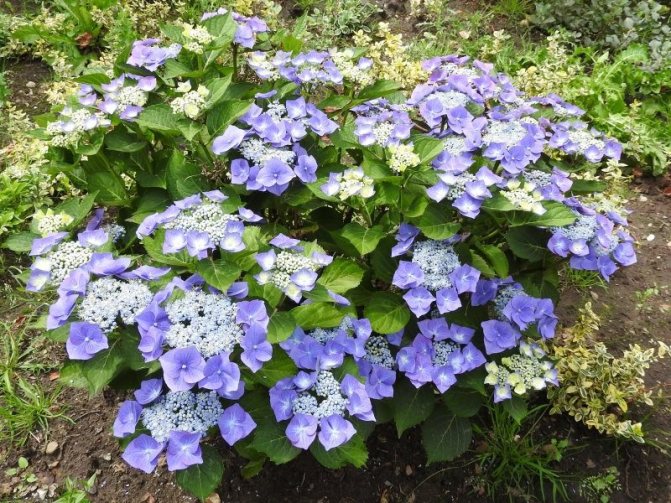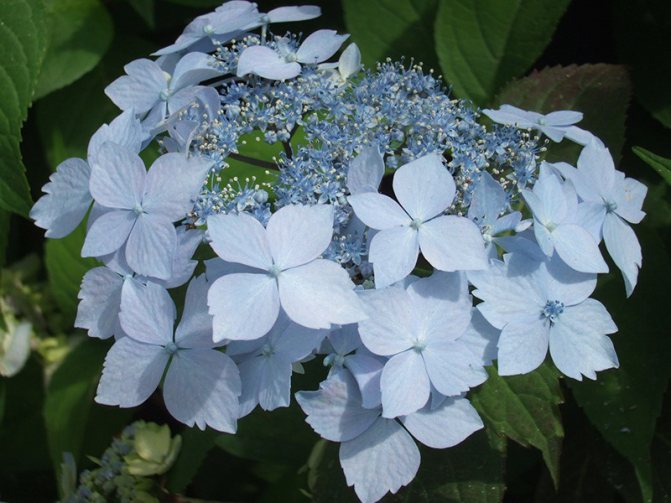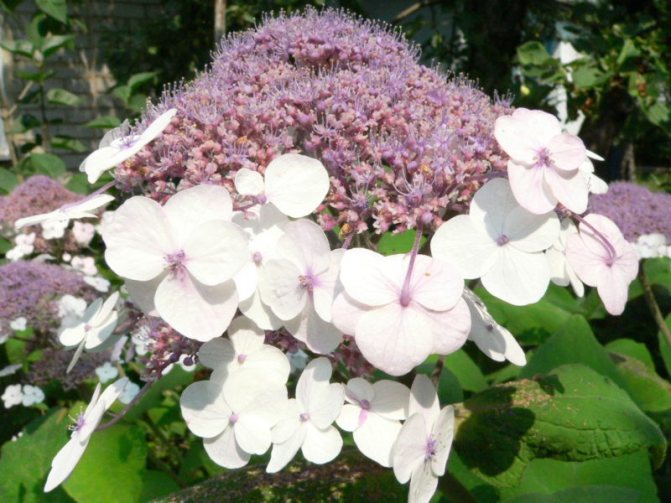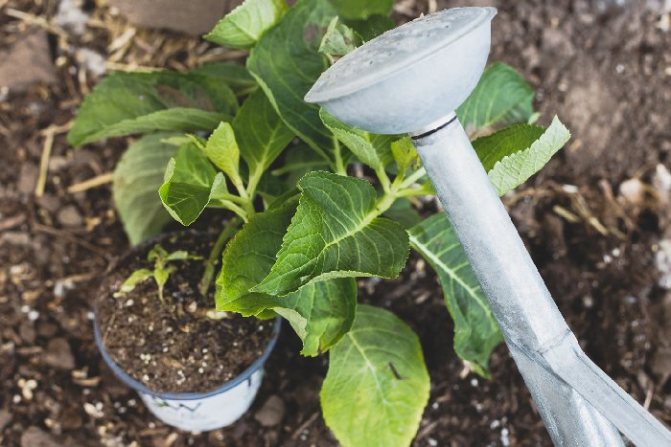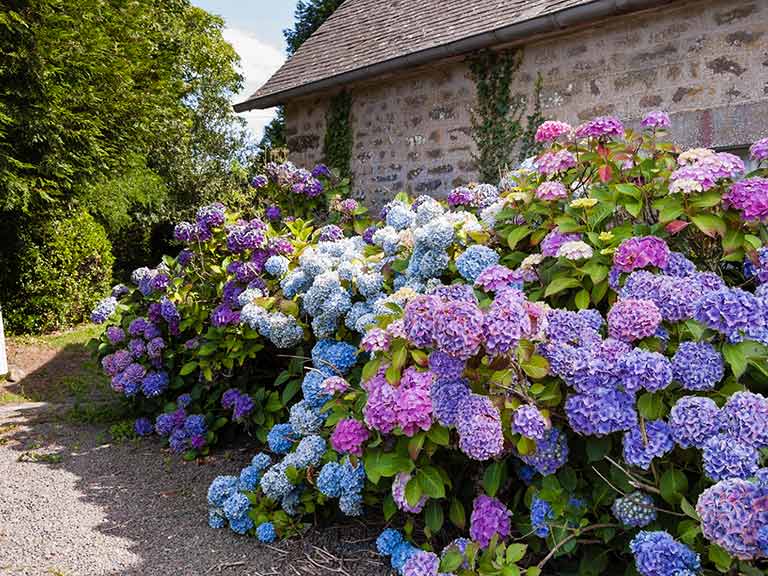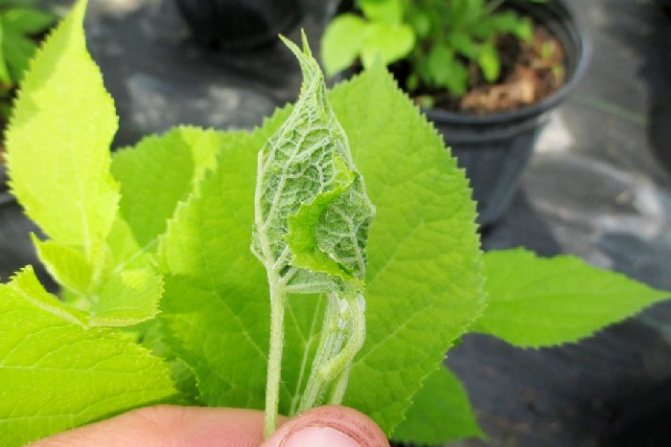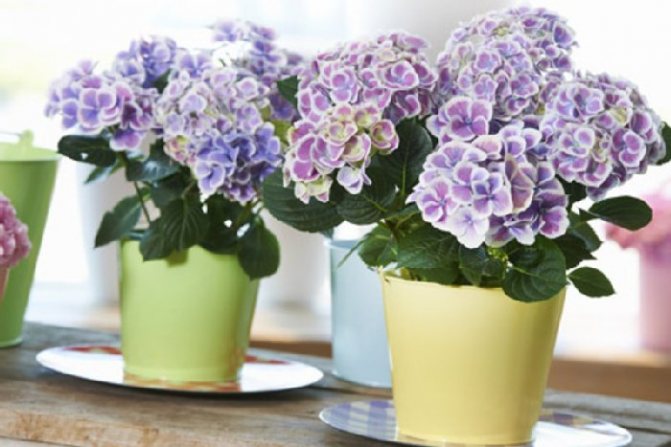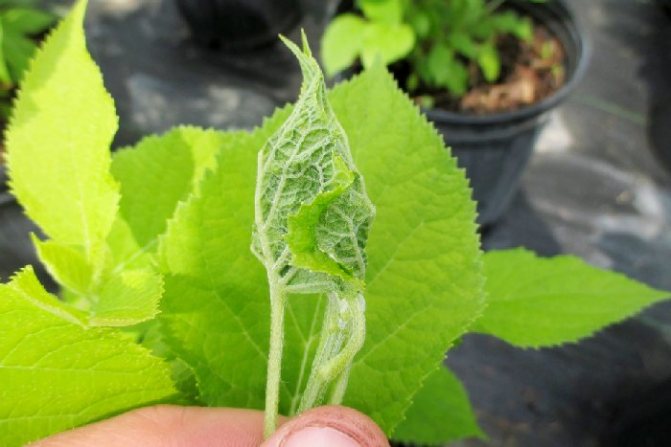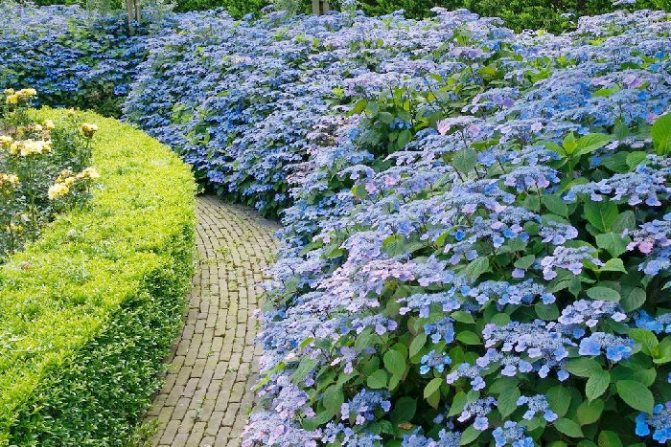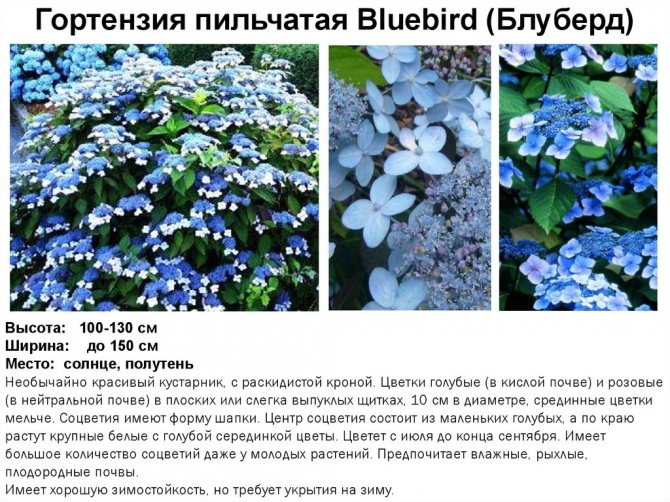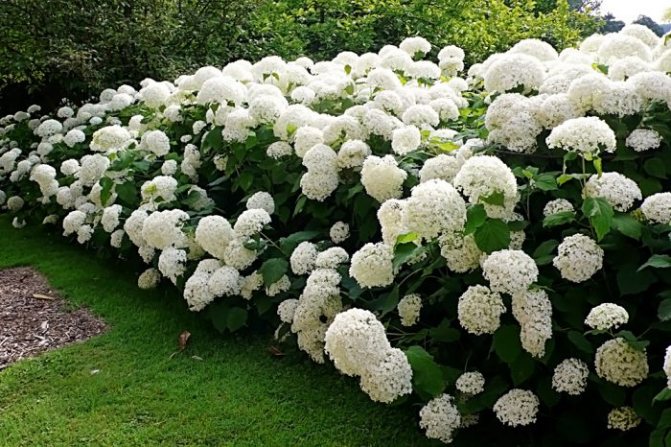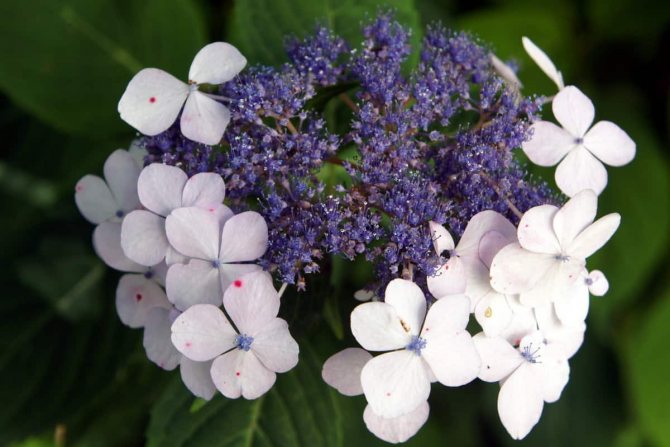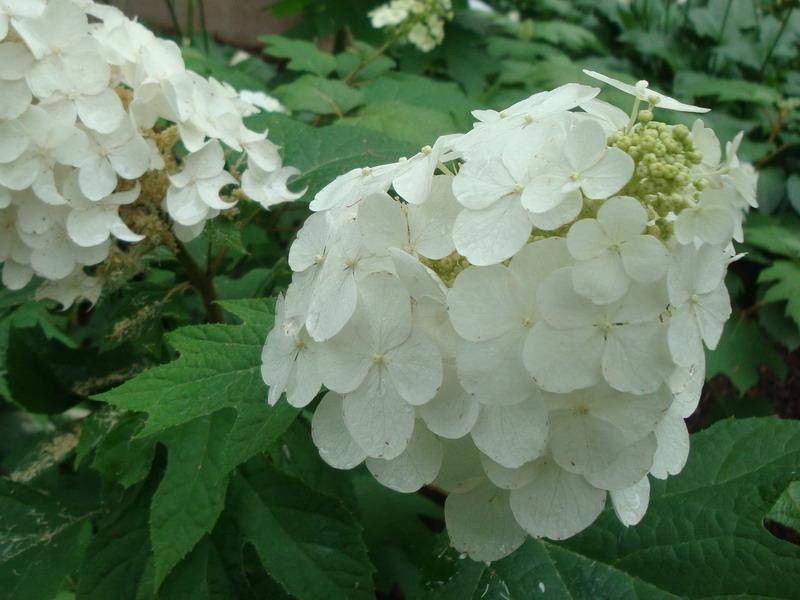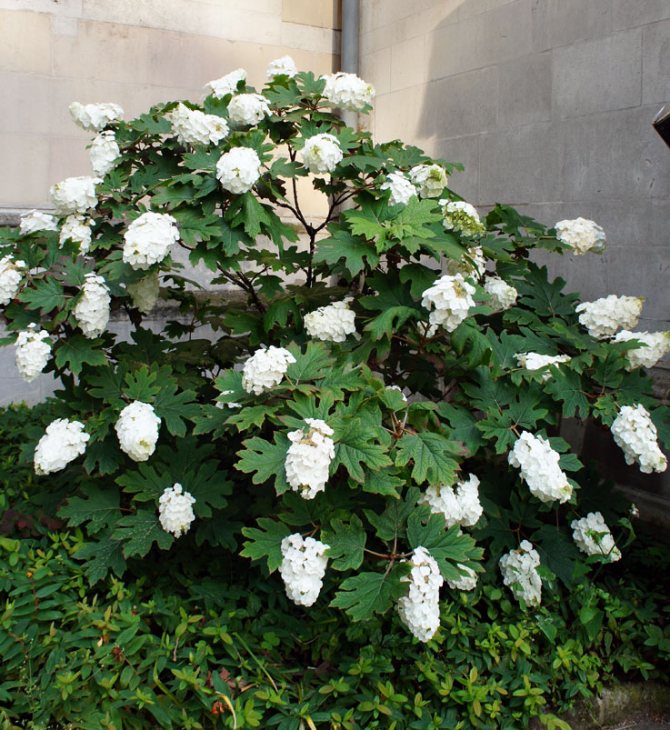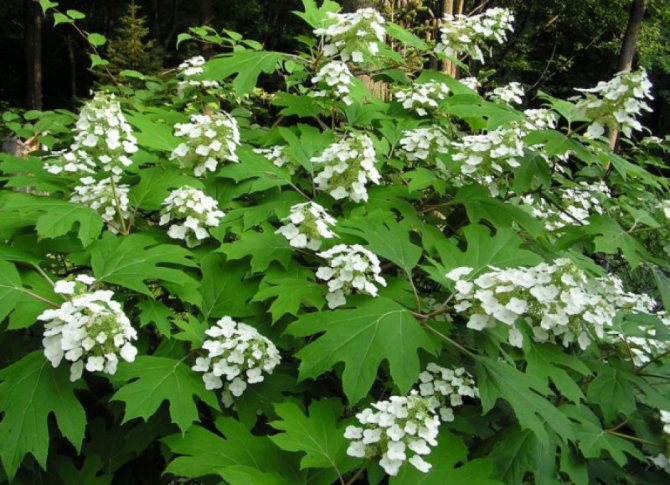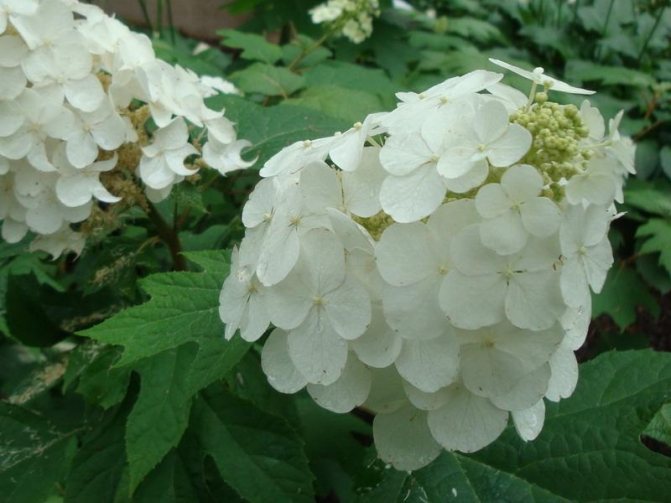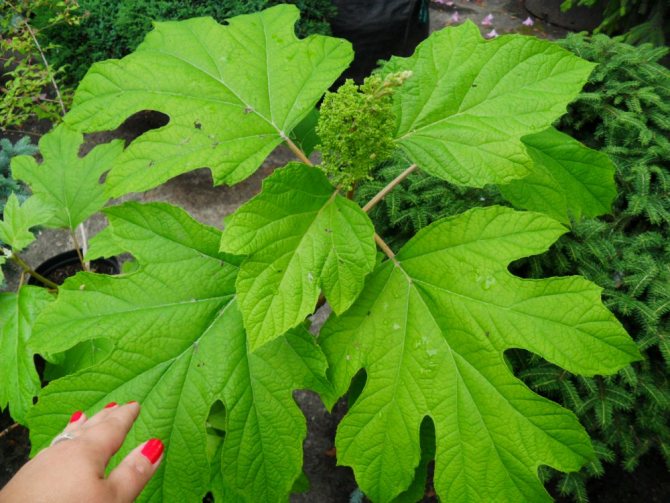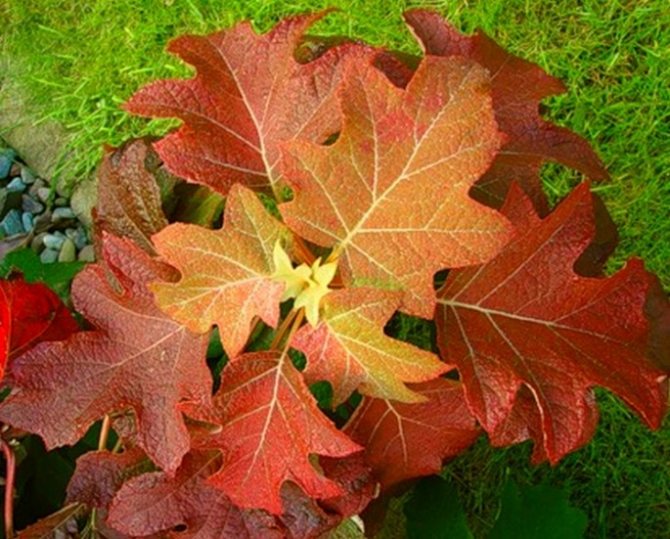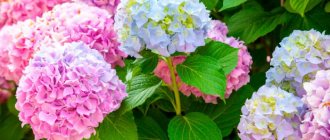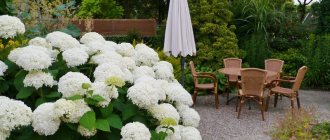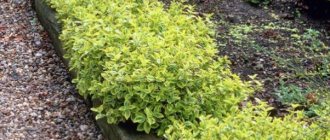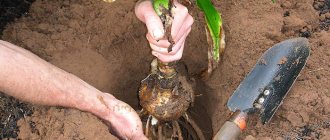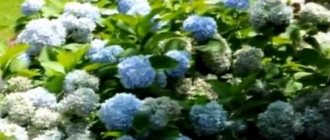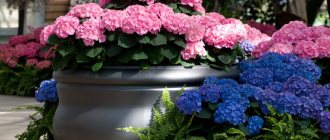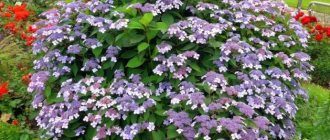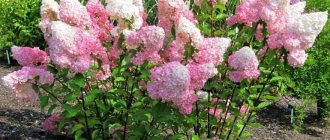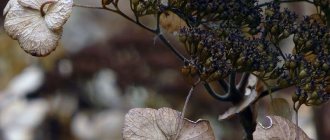Hydrangeas are shrubby flowers with excellent decorative properties, for which they are prized in landscaping. The historical homeland of culture is Asia and South America, and it was brought to Europe at the beginning of the XIV century. To date, breeders have bred more than 80 plant species, but the most popular is the Bluebird serrata hydrangea. The bushes of this flower have a fluffy crown, so they not only look great on their own, but are also well suited for creating hedges.
Description of Bluebird serrated hydrangea
Hydrangea serrata varieties Bluebird was bred in Japan... The plant itself is a shrub with a strong, branched trunk, ranging in height from 100 to 120 centimeters.
The crown can grow up to 1.5 meters wide. The leaves have a rich green color and an oval shape, they have jagged edges at the edges.
The caps of the inflorescences are shaped like a flat umbrella and can reach 10 centimeters in diameter. Inside are located small pink or purple flowers with blue stamens.
At the edges, the flowers are already larger, they are characterized by a color from light purple to bright blue.
An interesting feature of the variety will be shallow roots, only 40-45 centimeters. With proper care, this shrub will bloom from July to September.
Also Bluebird refers to winter-hardy shrubs and can withstand temperatures down to -20 degrees.
Advantages:
- gorgeous appearance and unusual shade of inflorescences;
- good frost resistance;
- immunity to pests and most diseases.
Disadvantages:
- high level of occurrence of the root system;
- whimsy to the composition of the soil and the quality of care;
- fear of direct sunlight.
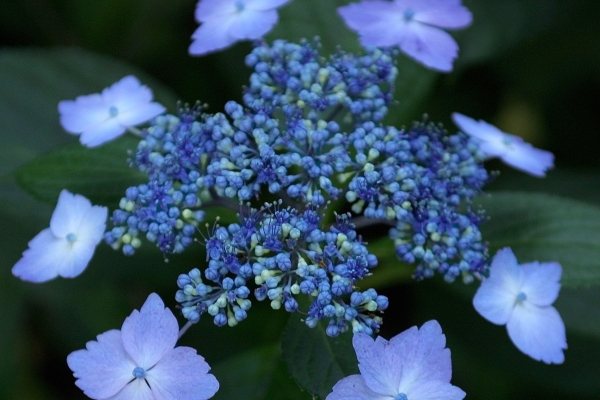
Advantages of the variety: winter hardiness, chic appearance and unusual shade of inflorescences
Diseases
Hydrangea is a disease-resistant plant, but there are some among them that the shrub cannot cope with - this gray rot, fungal diseases, downy mildew. The reason for this dew is high humidity, it is treated by normalizing the microclimate around the plant.
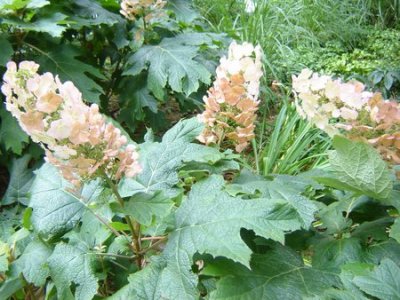

Also the shrub is prone to chlorosis - yellowing of the leaves. Its cause is an excessive amount of lime in the soil. It is treated with dressings with iron salts.
Among insects, great damage can be caused by aphids, pointed noses, spider mites and weevils... Spraying with Karbofos, Aktellik and other preparations will help get rid of small pests.
With proper care and cultivation, oakleaf hydrangea will delight you with its beauty for a long time - even without flowers, this plant amazes with its richness, showiness and will definitely become the highlight of your garden.
Now this shrub is gaining popularity and increasingly appears in the flower collections of professional gardeners.
Landing
Experienced gardeners recommend plant serrated hydrangea in late April-early May or mid-Septemberwhen the temperature becomes more moderate.
On average, the size of the pit will be 50 centimeters in width and depth. While digging the soil into it the following fertilizers are applied:
- 2 parts of humus;
- 2 parts of leafy soil;
- 1 part peat;
- 1 part sand;
- 20 grams of urea;
- complex mineral fertilizers according to the instructions.
If you compose any composition of hydrangeas, it should be borne in mind that the distance between them must be at least 1.5 meters.
During landing the root collar should be flush with the ground... After the seedling is in the ground, it must be watered and mulched.
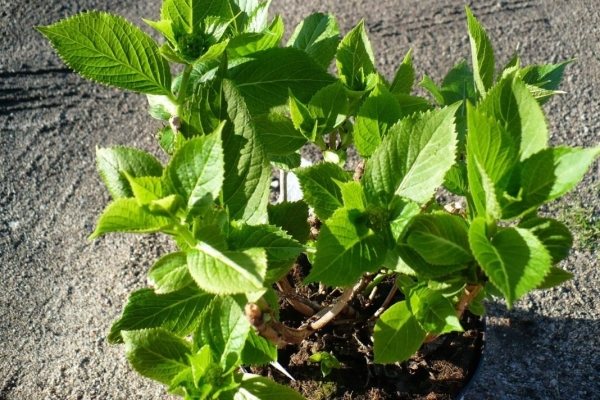

This species prefers to receive sunlight in a diffused form, you can plant a shrub in partial shade
Caring for Bluebird Saw Hydrangea is very easy... The main thing to consider is that the plant is very fond of warmth and moisture, so it is recommended to water it every day.
Also, if the air temperature rises to 25 degrees, the soil is moistened twice a day, and if more than 30 degrees, then three times.
So that the root system has faster access to oxygen and moisture, it is necessary to loosen the ground near the bush... But it should be borne in mind that this variety has a very high occurrence of roots and deep loosening is contraindicated for it.
In addition to timely watering, care must be taken to ensure that the shrub is not harmed by direct sunlight at midday. For this it is necessary to create artificial shading using a removable canopy etc.
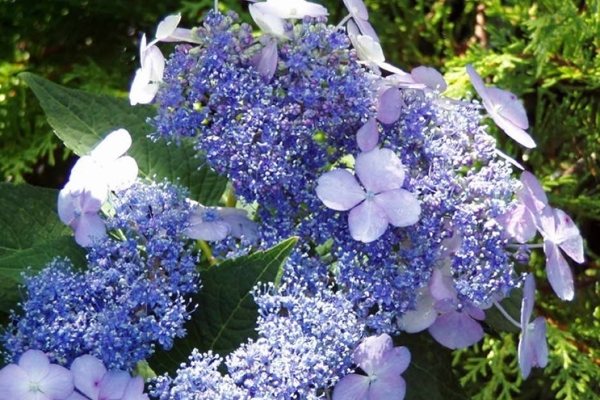

Care includes watering, shallow loosening and shading
Hydrangea is fertilized according to the following scheme:
- During the formation of buds and immediately after flowering, the shrub is watered with a mixture of a kilogram of peat, a kilogram of dry leaves and 500 grams of humus, which are then diluted with 2.5 liters of infused water.
- Then, throughout the flowering period, compost or dry foliage is added once a week to the root zone.
Handle nitrogen-containing fertilizers with care, with an overabundance of them, the flowering will be very abundant and can damage the shrub itself. Therefore, urea or rotted manure is applied only at the beginning of the growing season in moderation.
In addition to watering and feeding, the serrated Bluebird hydrangea requires annual pruning, the best time for it is autumn.
In the course of work, dry, weak, uneven and dead shoots are removed. You should also clean the shrub from the remaining foliage and faded inflorescences.
To stimulate the growth and flowering of the plant, all shoots are cut into 2-3 buds.
Care for serrata hydrangea:
Distinctive features
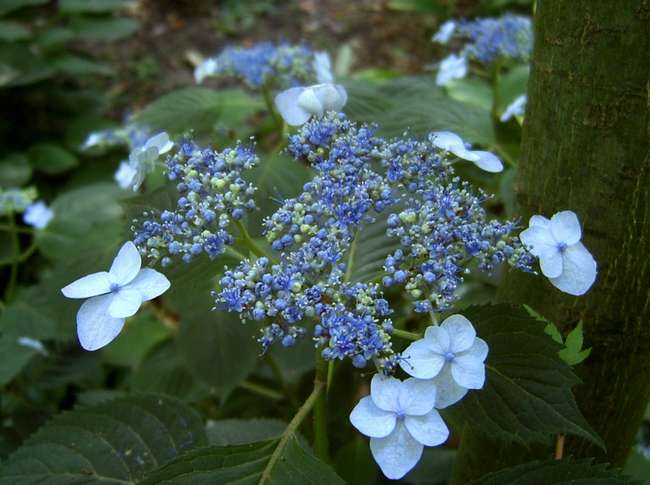

Let's take a closer look at them. Bluebird serrated hydrangea differs from its counterparts in many ways. Among the main differences, breeders distinguish the following:
- Sprawling bushes with a lush green crown and large leaves.
- Love for abundance of sunshine and moisture.
- Stronger stiffened trunk.
- A powerful and well-developed root system, which is located at a relatively shallow depth, due to which top dressing gives results very quickly.
In addition to all of the above, this variety has a longer and more active flowering period. With the right care, you can enjoy the incredible beauty of the bush from mid-summer to fall. It is also worth noting the winter hardiness of the Bluebird serrata hydrangea. The plant is able to withstand frosts of twenty degrees, so it adapts well in many regions of our country.
Preparing for winter
Bluebird serrated hydrangea enough tolerates cold well in central Russia, but it is necessary to build a shelter until the plant gets stronger, that is, up to 4-5 years.
Also, you will have to protect the shrubs for the winter in the northern and cold regions.
The work is carried out adhering to the following rules:
- First you need to do sanitary pruning.
- Then phosphorus and potash fertilizers are scattered under the bush.
- In frosts down to -5 degrees, the shrub is spud and covered with polyethylene.
- Up to -15 degrees, the hydrangea is tied with a rope, spudded, covered with spruce branches, and a film is wound on top.
- At temperatures up to -20 degrees, the branches are bent to the ground and fixed with metal brackets, sawdust, coniferous branches, old blankets, etc. are placed on top.
- In frosts down to -30 degrees, the shrub is wrapped in a metal grate, covered with bricks and covered with old warm clothes on top.
If you correctly prepare the hydrangea for winter, then in the spring the plant will start growing faster.
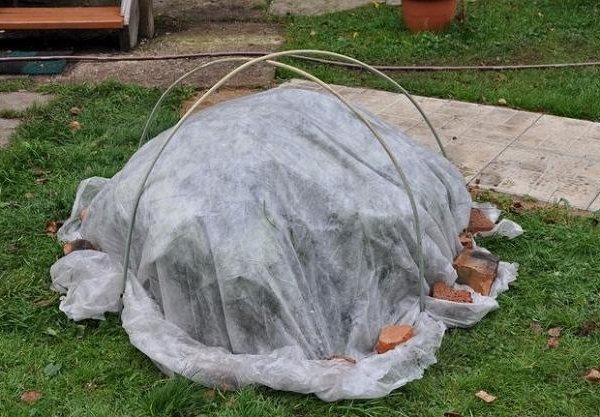

It is necessary to protect shrubs for the winter in the northern and cold regions.
Care
In early spring we remove the upper buds to stimulate the expansion of the shrub. This is also the time to remove dead flowers that protected the buds from frost in winter. Old, dry shoots are cut out at a height of 2-5 cm from the ground.
In autumn, cover the main part of the hydrangea with dry leaves. Sensitive varieties can be wrapped in straw or other dry material and wrapped in a cloth or film with holes. Cover the roots of more resistant plants with a thick layer of dry mulch. Hydrangeas growing near hedges or near trees do not require shelter for the winter.
Diseases and pests
Bluebird serrated hydrangea is resistant to almost all pests. Most often it is affected by Chlorosis or Powdery Mildew.
With chlorosis the leaves of the plant begin to lighten, while the veins do not change color. As a treatment and prevention, hydrangea is treated with a mixture consisting of 4 grams of potassium nitrate, 4 grams of vitriol and a liter of water.
When powdery mildew appears brown spots and silver bloom appear on the leaves. An effective control measure will be a solution of 10 grams of laundry soap and 2 grams of copper sulfate, diluted in a liter of water.
Characteristics, description and differences from other species
Root system
The root system is spreading, wide, fibrous, up to 40 cm deep. The large suction surface and shallow root system cause the plant to react quickly to fertilizers and soil contamination.
Leaves
The length of the leaf is slightly less than that of the closest large-leaved relatives - up to 12 centimeters. Oval, pointed at the ends, they have saw-like serrations along the edges. They are the hallmark and distinctive feature of the serrated hydrangea.
Flowers
The type of inflorescence is a corymbose panicle up to 8 centimeters in diameter. B - many small fertile variegated blue-white or white-pink flowers capable of cross-pollination. The edges of the inflorescence are decorated with larger four-leafed sterile flowers that do not have reproductive organs. After blooming, they have a monochromatic milky pink or blue color.
Trunk
A strong, branched, barked trunk of a shrub is hidden under a luxurious cap of inflorescences and foliage and is almost invisible. It has a height of up to 1.5 meters, the strongest at the base, low branches.
Features of this variety
This variety was presented to us by Japanese breeders.
The plant looks like this:
- branched shrub up to 120 cm in height and up to 150 cm in width;
- oval, with light denticles along the edges, bright green leaves;
- inflorescences in the form of a cap up to 10 cm wide (inside the flowers are smaller, and at the edges are larger);
- the basic shade of the petals can be considered blue, although the color of the inflorescences can be different, from heavenly to deep blue and even purple (it all depends on the soil in which the bush grows - I will discuss this in more detail below).
Despite the superficial occurrence of roots (maximum 45 cm), the variety is winter hardy. Of course, it is not suitable for Siberia, but for the central strip it is quite: it can withstand up to -20 degrees.
Blooming period is long. It starts in July and ends in September.
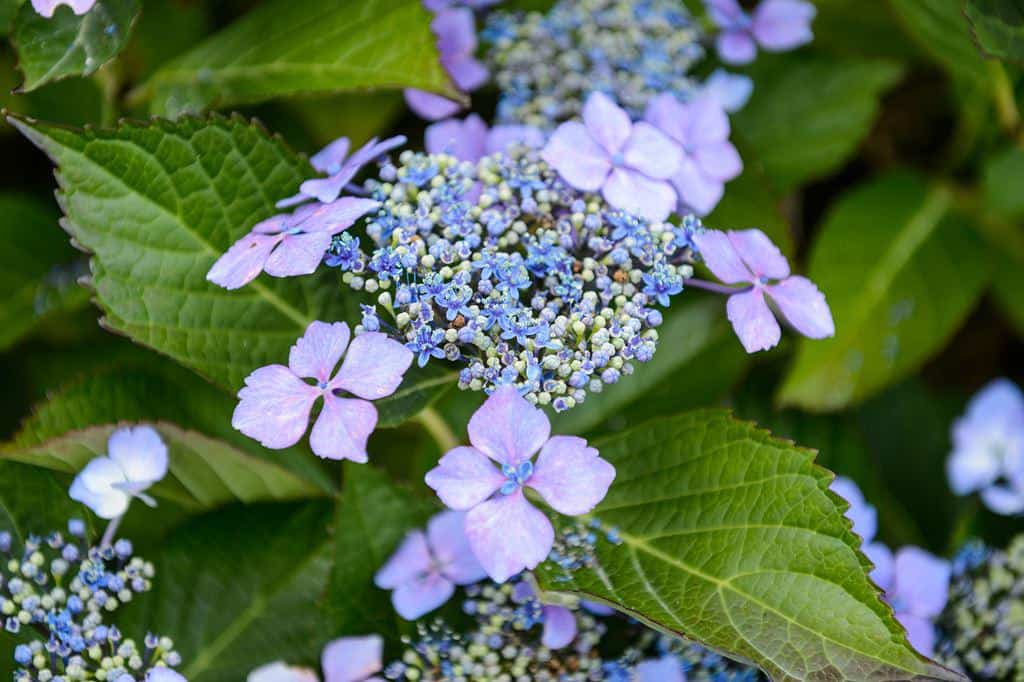

Advantages of the variety
- Even if you already have a white or rarer pink hydrangea, you can buy this blue variety as well.You will be able to create an amazing, rarely seen hydrangea garden.
- When blooming, the bushes exude an amazing honey aroma.
- The bush has good immunity to harmful insects and many diseases.
- It is a relatively hardy variety.
Disadvantages of Bluebird
This variety is somewhat capricious. First, he is afraid of the sun (direct rays). Secondly, not every soil is suitable for him. And finally, if the bush is abandoned, its flowering period will be significantly reduced.
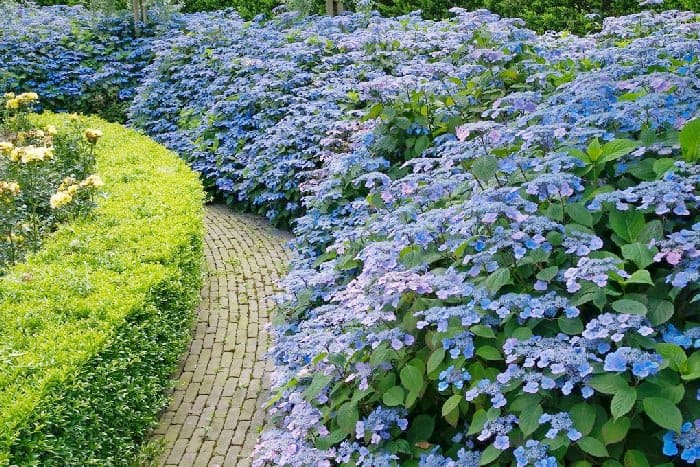

Varieties
- "Bluebird" (Bluebird), or "Bluebird" - blooms from July to September. Reaches a height of 120 centimeters. Produces large inflorescences with a diameter of 20 cm. On calcareous soils, flowers range from pink to purple, on sour soils they are turquoise. Light green leaves turn red in autumn. Frost resistance up to -23 ° C;
- "Diadem" - blooms from June to August. It grows up to 100 cm. It has small inflorescences with intense red or blue fragrant flowers, the leaves turn purple in autumn;
- "Grayswood" - blooms from June to August. Can reach 200 cm in height. It blooms with white-pink flowers that turn red;
- "Intermedia" (intermedia) - blooms from June to August. The flowers are fertile blue, barren white-pink, the leaves are dark green. It tolerates partial shade well;
- "Miranda" - grows up to 75 cm. Produces flowers pale blue or pink, depending on the reaction of the soil;
- "Preziosa" (Preciosa) - blooms from July to September. It grows up to 150 cm. Pale pink flowers change color to rich red. Leaves are brownish;
- "Rosalba" (Rosalba) - reaches up to 120 cm in height. Fertile flowers of the variety are red, barren pink-white, leaves are light green.
Planting hydrangeas
- Time. Serrated hydrangeas are planted on open ground in spring (late April - early May) or summer (tenths of September).
- A place. Bluebird hydrangea loves lighting, but not direct, but diffused. It can also be planted in partial shade. The ideal part of the plot for her would be east or west, next to trees, a house or a fence.
- Pit. Do it half a meter both in width and depth. Preparing the flower bed for the "settlement" of the new "inhabitant", dig up the ground, applying organic fertilizers. It can be a mixture of 1 part peat and 2 parts humus. If the soil is too clayey, "dilute" it with sand. If you have a summer cottage and there is no place to take organic matter, "fill" the soil with urea (put 20 g in the ground under the bush) or with a complex mineral fertilizer.
- Distance between bushes. There should be at least 1.5 meters of free space from the hole you dug to the next (or other bushes / trees growing on the site).
- Root collar. Do not deepen it, leave it flush with the ground.
After planting the bush, water it, and then mulch the soil near the trunk.
Influence of soil composition on the shade of flowering brushes
Knowing what is the composition of the soil in your area, you can "navang" what shade the flower brushes will get.
Acidity. The higher the Ph of the earth, the bluer the flowers. If the soil is low in acidity, the petals will have a distinct pink or purple hue.
Ground games. By introducing various dressings under the bush that change the acidity, you can observe how the flowers of the Bluebird hydrangea change.
For example, iron salts or alum are added every 2 weeks. Result: The pinkish brushes will turn blue.
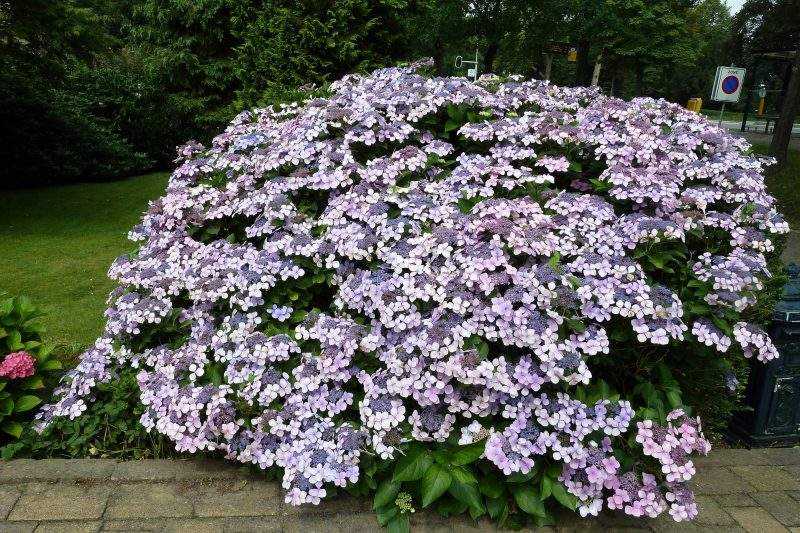

And if only the left side of the bush is watered with potassium permanganate every 3 days (with a weak solution - no more than 3 g of powder per liter of water), and only the right side with a solution of aluminum sulfate, you will grow a bush with flowers on which will have a different shade: on one side pink, on the other blue.
Landing features
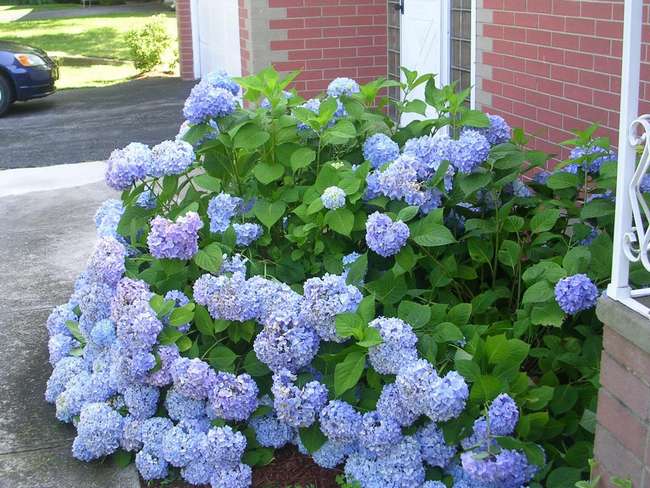

This aspect should be given special attention. As mentioned earlier, Bluebird serrated hydrangea (Bluebird) refers to plants that love warmth and sunlight, so when planting them outdoors, it is very important to choose the right place. It is best to plant shrubs near buildings or trees that provide shade for them. However, within a radius of three meters from the hydrangea, there should be no other plants that will take moisture and nutrients from the soil, which will negatively affect the growth and development of the flower.
It is best to transplant seedlings to open ground in the middle or late spring, so that they have time to take root normally and get stronger in a new place before the onset of cold weather. The width of the hole should be about half a meter, and the depth should be 60 cm. Between the bushes, you need to retreat at least one and a half meters so that each of them feels comfortable. Bluebird serrata hydrangea adapts well to any type of soil, but a substrate would be an ideal option for growing, for the preparation of which two parts of leafy earth and humus and one part of sand and peat are taken. You can also add a little urea, as well as organic and complex fertilizers to the mixture.
Basic principles of care
- Watering. The most important part of hydrangea care. Bluebird should grow in permanently damp ground. If it dries out, the quality of flowering will suffer immediately. Therefore, in the summer it makes sense to bring the hose directly under the bush. At 25 degrees, water it in the morning and in the evening, and at 30 and above - generally three times a day.
- Loosening the earth. Hydrangea roots need to breathe, so sometimes fluff the soil around the bush so that frequent watering doesn't "cement" it. But do not take a shovel, because Bluebird's roots are not deep - use a glanders (hoe) and another small tool.
- Shading at noon. If you see direct rays of the sun falling on the branches of the hydrangea at lunchtime, protect it with a canopy.
- Pruning. It is definitely held in the fall. Firstly, all defective branches (dry, broken, diseased) are removed from the bush. Secondly, by leveling the crown, 2-3 nodes are removed from the branches from above. The logic of such pruning is simple: the shorter the branches, the less the bush evaporates moisture, which means that it will winter better. Hydrangea can also be slightly trimmed in summer if it seems to you that the shape of the bush is not ideal.
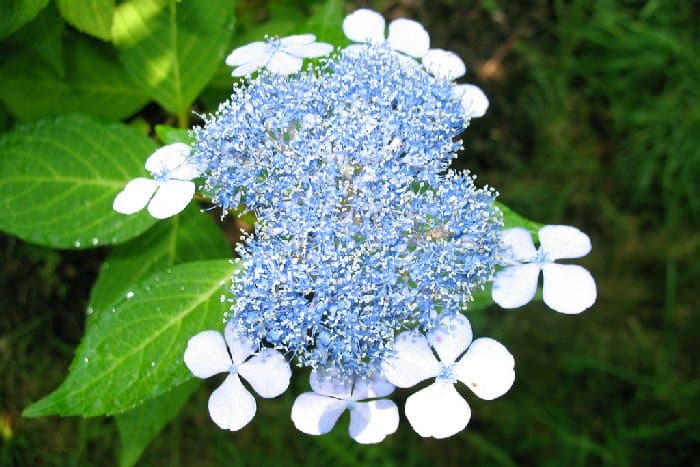

Fertilizer
This is a separate topic. Like other varieties of hydrangea, Bluebird blooms profusely, so you cannot do without top dressing.
Rejuvenation
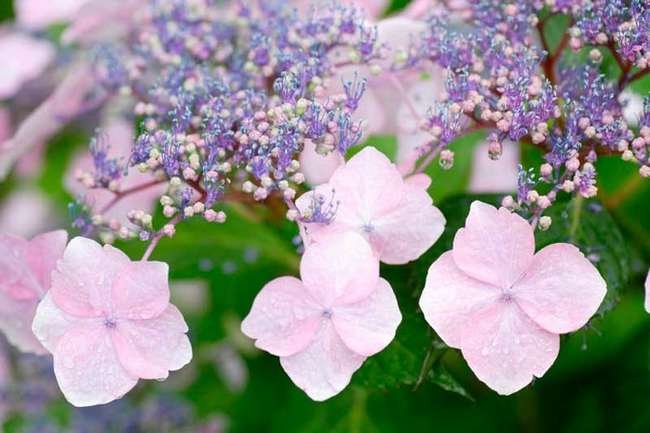

So what do you need to know about this? Pruning when growing and caring for hydrangeas is not just a preventive measure necessary to give the shrub an aesthetic and more attractive appearance. Rejuvenation is a mandatory measure that must be carried out annually. It is recommended to shorten old shoots and remove weak shoots in early or mid-autumn, when the plant goes into hibernation. Pruning is beneficial in that it allows you to reduce the amount of moisture evaporated from the flower, which has a positive effect on its health and increases resistance to various diseases and harmful insects.
Let's remember the most important information ...
- Hydrangea Bluebird is prized for its blue flowers. True, their shade depends on the acidity of the soil in which the bush grows - if it is low, the petals will actively turn pink.
- The bush is planted in early May. It is better to choose a place slightly shaded by other trees, since hydrangea does not like to grow in the sun.
- Caring for this ornamental shrub is easy, but you don't have to pull down your sleeves. In the heat, hydrangea must be watered every day. Also, a plentifully flowering bush needs frequent fertilization (be careful with nitrogen, in the summer it is no longer needed for hydrangeas) and constant autumn pruning.
- This variety is winter-hardy, so an adult bush in the middle lane does not need to be heavily insulated for the winter. But young plantings (up to five years of age) are still better covered.
An enthusiastic gardener will tell you about other beautiful varieties of hydrangea. And he will not just tell, but show the well-groomed, flowering bushes in his own garden:
Serrated hydrangea is grown in Russia. It blooms with beautiful flowers of delicate shades. With proper agricultural technology, the bushes grow, annually pleasing with their lush flowers.
What do breeders say about the variety?
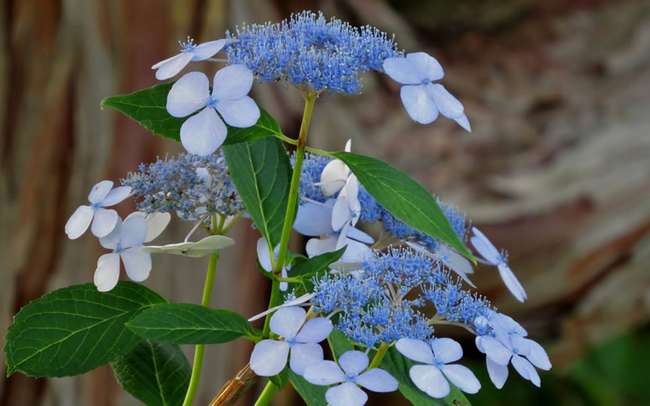

If you want to decorate your backyard, then one of the best plants for this, of course, will be the Bluebird serrata hydrangea.Reviews of experienced gardeners note the decorative and unpretentiousness of the plant. Caring for him does not require any special knowledge and skills, so everyone can handle the cultivation. At the same time, shrubs look beautiful not only by themselves, but also as part of compositions, which allows them to be successfully used in landscape design.
Description of the plant
Hydrangea serrata is a type of large-leaved hydrangea. The homeland of the ornamental plant is East and South Asia. Blooming flowers will be a wonderful decoration for a garden plot, they can be included in the composition of bouquets, dried and made ikebana.
There are several varieties of this species:
- Hydrangea serrated Bluebird;
- Hydrangea Preciosa.
Hydrangea serrata Preciosa
Description of the plant:
- Shoots are erect, grow up to 150 cm in height, up to 60 cm in width;
- The leaves are rich green, oval in shape, the end of the leaf is pointed;
- The inflorescences are lush in the form of a cap, lacy, the petals are concave and convex;
- Barren flowers are blue or pink, fertile flowers are blue or white;
- The composition and acidity of the soil affect the color of hydrangea finely serrated;
- The flowering period begins in June. Depending on the variety, the flower can decorate the garden until September;
- The plant is perennial, it is necessary to make a shelter for the winter.
On a note. To obtain a pink shade of flowers, hydrangea is watered with a weak solution of potassium permanganate. To obtain a rich blue color, 3.5 g of potassium alum must be diluted per 1 liter of water.
Photo
See oaky Hydrangea in the photo:
The hydrangea flower was first discovered in Japan. The largest number of hydrangea species are thermophilic, prefer the sun and die in cold conditions. Read about the rules for growing other varieties of garden hydrangeas - serrated and tree-like - on our website.
Agrotechnics
Conditions for active growth of hydrangea:
- The flower will grow and bloom well in fertile, moist soils;
- The acidity level of the soil should be 5.5 pH;
- If the acidity level is neutral or alkaline, then the soil is acidified by adding aluminum sulfate or peat to it;
- The plant can be planted in partial shade;
- The flower does not tolerate drafts, it cannot be planted on the eastern side of the site;
- The bushes are considered winter-hardy, but when the temperature drops below -28 degrees, a shelter must be made for the hydrangea.
Wintering
The winter hardiness of serrata hydrangea increases over the years. All young shrubs, without exception, should take cover for the winter.
The hydrangea feels more comfortable in the southern winter; it will be extremely difficult for it to survive temperatures below -40 ° C. The southern climate or the climate of central Russia with winter temperatures of at least -25 ° C is suitable.
Preparation for wintering is carried out from mid-September. First you need to cut off the old branches, remove the dried, fallen leaves. Before covering, the hydrangea must be fed with phosphorus-potassium fertilizer.
Shelter methods for the winter:
- Spill high and cover with a plastic bag - winters down to -5 ° C.
- Tie the bush with a rope. Hump high and cover with sawdust, spruce branches. Cover on top with several layers of plastic wrap and secure with wooden boards. This method will help to survive the winter down to -15 °.
- Trim dry shoots as much as possible. Select bundles of 1-2 branches, bend to the ground and fasten with wooden staples. Throw the bush with sawdust, spruce branches, dry leaves, cover with a sheepskin coat or an old blanket. Lay several layers of polyethylene on top, secure with boards or bricks. The method is suitable for winters -15 - -20 ° C.
Important! For maximum insulation, use a metal mesh frame that can be covered with old clothes on top. You can brick the structure instead of the mesh. Such structures are also suitable at -30 °.
Hydrangea serrata Preciosa
Sprawling bush up to 2.5 meters in height.The flowers are sterile, greenish, pink or blue; by autumn they turn crimson. Green leaves turn burgundy in autumn. Prefers partial shade, moist acidic soil. Frost resistance - up to -23 °.
Hydrangea serrated bluebird
Wide low spreading shrub up to 1.5 m high and wide. In the inflorescence, fertile flowers are red, lilac with bluish stamens. Sterile flowers are white, blue, lilac. The leaves are green and red with a red shank. Loves moist soil and light. Transfer temperature -18 °.
Hydrangea serrated vierle
Miniature bush with blue flowers. Green foliage turns purple or burgundy in autumn. Finicky. Needs to maintain constant soil moisture, fertilizer, partial shade. Not hardy.
It is carried out from April to May in a hole with a depth of 10 cm greater than the length of the root system. Before planting, the soil is loosened, mineral fertilizers, peat, sand, humus are added to the hole. The optimal distance between shrubs is at least 1 meter. Within a radius of 3 meters, there should be no large moisture-loving plants that can compete with hydrangea for moisture.
Light mode
Penumbra, diffused light. It is preferable to plant against a wall or fence, which will serve as a shelter for hydrangeas both in summer and in winter. Feels great under a roof canopy, limiting direct sunlight that is harmful to the shrub. It will be a win-win to use a reclining canopy when the sun is at its zenith.
Thermal conditions
Garden varieties have mastered a wider temperature range than indoor varieties - from -2 ° to + 25 °. It is possible to reduce the destructive effect of high temperatures in summer by watering and folding canopy two or three times a day. It must be remembered that the main guideline for starting the preparation of hydrangeas for wintering is the night temperature below -2 °.
The serrated hydrangea is moisture-loving and requires abundant daily watering. During dry summers, it is especially important to maintain a constant moderate soil moisture. At + 30 ° and above, three times watering is shown, at + 25 ° - two times. The use of sprinklers is possible.
Fertilizer / feeding
Fertilization is carried out three times a year: during planting, in the "bud" period and at the beginning of flowering. The simplest fertilizer is a mixture of peat, humus and dry leaves in a 2: 1: 2 ratio. When planting, the mixture fills the space free from the roots in the hole. During the periods of bud ripening and flowering, fertilizer is applied to the root space under the bush. To give it a liquid consistency, you need to fill a five-liter bucket half-filled with the mixture to the brim with compost diluted with water.
Nitrogen-containing fertilizers are applied strictly according to the instructions, they do not need to be abused if you want to get abundant flowering.
Top dressing is carried out once a week. Compost and dry foliage are used as top dressing.
To loosen the earth, sawdust and sand are added to the compost.
Bloom
The flowering period is July and August.
Interesting! The soil environment can influence the shade of hydrangea flowers. Alkaline soil gives inflorescences warm pink hues, while flowers turn bluish on acidic soil.
Once every three days, water one side of the bush with a slightly pink solution of potassium permanganate, and with a solution of aluminum sulfate on the other, and you will get both blue and pink flowers on one plant. The composition of the solution: 2-3 grams of powder per 1 liter of water.
Hydrangea propagates by seeds and cuttings.
Cuttings are prepared before the buds open. To do this, in a young branch, select an area with 1-2 knots and leaves. Cross the branch without offset from the top node at an angle of 90 °. Cross the branch obliquely under the lower node, cut off the massive leaves, leaving a few small ones.
Treat the cuttings planted to a depth of 1-2 cm with indoleacetic acid and spray and water daily.
Pruning
Performed in September before wintering. To do this, remove 2-3 upper nodes with pruning shears, align the "cap" of the bush. Branches without inflorescences and old dried leaves and branches are cut off.
In the fall, pruning is mandatory, its purpose is to reduce the area of moisture evaporation from the wintering plant. In the summer, the bush is pruned at will - to give shape and for more tillering. Once every 2 years, a radical cutting off of dead shoots is required.
Reproduction of culture
There are several breeding options for hydrangeas. The most common is grafting. Cuttings are cut in summer from healthy and strong bushes.
On a note. Cuttings - the middle part of the shoot with 2 leaf nodes, without lower leaves and flowering tops.
Tips for germinating cuttings:
- For root growth, cuttings are placed in water with the addition of special preparations (Etamon, Kornevin, Heteroauxin, Zircon);
- For sprouting roots, you can use the folk method: 1 teaspoon of honey in a glass of water;
- After good roots are formed, the cuttings can be planted in open ground. After 4 weeks, they should take root in a new location. A prerequisite is the presence of a shelter;
- In late spring, young bushes can be transplanted to a permanent place.
Another uncomplicated way to propagate hydrangeas is by layering. It is necessary to choose a strong adult bush, in the spring, dig in the lower branches along the entire length. In the fall, shoots are formed on the buried layers, next spring they can be planted in a permanent place.
Tips for rooting hydrangea seedlings in the fall:
- Remove leaves and shoots from the seedling;
- Arrange the branch so that it is at the top, the roots at the bottom;
- Sprinkle the roots with earth;
- Make shelter.
The easiest way is to divide an adult bush. This is the most optimal way to transplant a plant.
Reproduction
Hydrangea serrated in summer is propagated by herbaceous cuttings from the tops of young, non-flowering shoots. Before the procedure, it is necessary to saturate the plant well with moisture before taking cuttings. Shoots saturated with water take root more easily. For seedlings, tops are selected that have at least two leaf nodes. Young plants should spend autumn and winter in a warm greenhouse.
Serrated hydrangea can be propagated by layering. In spring, the side shoots should be pressed to the ground and covered with soil so that the ends of the shoots stick out above the ground. We attach the tops of the shoots to the props.
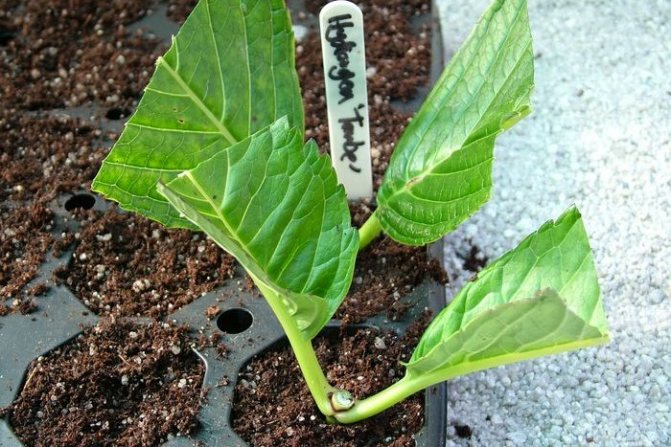

Diseases of oaky hydrangea
Despite its resistance to many diseases, oakleaf hydrangea may not fight gray rot, downy mildew or fungal infection. It is important to know about the causes of diseases. For example, due to high humidity, powdery mildew appears. Often, in order to get rid of it, it is enough to normalize the microclimate near the bush.
Or, due to the high content of lime in the soil, the plant may develop chlorosis (yellowing of the foliage). Iron supplements will help here.
Hydrangea can be overtaken by an invasion of aphids, pointed noses, spider mites or weevils. Disposal is impossible without spraying with special preparations (Karbofos, Actellik).
Proper care of this magnificent plant guarantees long-lasting beauty. Oak-leaved hydrangea is one of the few that pleases with its uniqueness, both in flowering and faded state. Spectacular and colorful, it is becoming more and more popular every year among both beginners and professional gardeners.
Open ground transplant
Hydrangea Anabel - tree species, description and care
To plant a plant in open ground, you will need to prepare a soil composition of fertile humus, rotted foliage, peat and sand in a ratio of 2: 2: 1: 1.Landing holes should be dug in advance, their depth should be about 35 centimeters. The distance between plants must be at least one meter. The landing procedure itself is quite simple:
- A previously dug hole is thoroughly spilled with water.
- An escape intended for planting is neatly placed in it.
- The landing site is covered with earth.
- The soil around the plant is tamped.
- Plentiful watering of the hydrangea seedling is carried out.
- Mulching planting with sawdust or needles to a height of 10 cm.
Care features
The frequency of watering depends on the season and the amount of rainfall. In spring and autumn too often it is not necessary to moisten the soil. In hot weather, watering the crop is 1-2 times a week. A few days after watering, the soil should be carefully loosened and mulched.
It is recommended to apply fertilizer several times during the season. Without this manipulation, it will not be possible to achieve a lush flowering culture. It is worth feeding a hydrangea at least once a month. From the beginning of the growing season until the appearance of buds, an infusion of mullein is used.
During the budding period, it is worth using fertilizers based on potassium and phosphorus. This helps to make the flowering more abundant.
In order for the hydrangea to bloom magnificently and retain its decorative effect, it must be cut off. To do this, it is worth getting rid of dry and damaged branches. Shoots that are directed towards the inside of the crown are also removed. When pruning in autumn, it is worth getting rid of old inflorescences.
This type of hydrangea is frost-resistant and can withstand temperatures down to -29 degrees. Therefore, oakleaf hydrangea can be planted and grown in the suburbs. However, culture feels best in the southern regions. In Siberia, the plant needs to be carefully covered or transplanted into a pot for the winter.
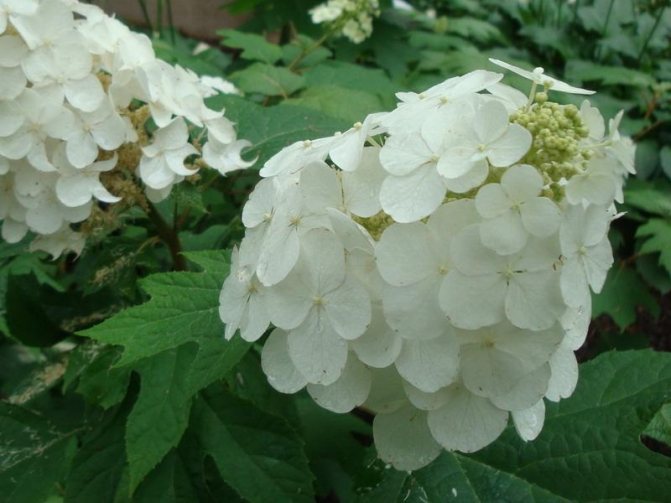

Care problems
The shrub practically does not get sick and rarely encounters pest attacks. At the same time, it is distinguished by its sensitivity to growing errors. In such a situation, the following problems arise:
- chlorosis of leaves - occurs when shrubs are planted in alkaline soil or excessive amounts of fertilizers;
- sunburn - observed when landing in a too sunny place;
- freezing of buds - due to the lack of winter shelter.
Advantages and Disadvantages of Plant Cultivation
The key benefits of culture include the following:
- abundant flowering;
- excellent resistance to dry weather;
- long flowering period;
- frost resistance;
- resistance to diseases and pests;
- variety of varieties.
At the same time, the plant also has certain disadvantages:
- intolerance to fertilizers containing nitrogen;
- the need to properly perform planting work;
- the need to plant in a well-lit place or in partial shade.
Pitfalls in the cultivation of this variety
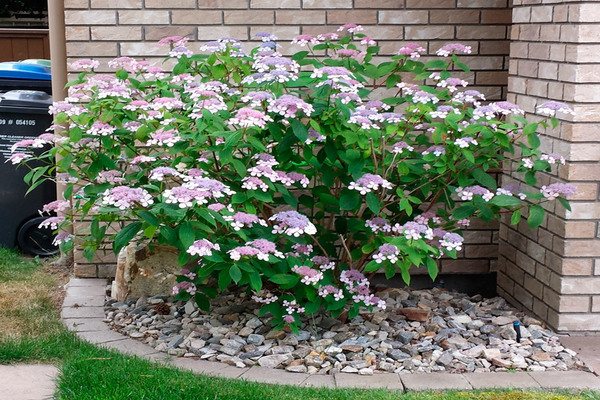

This variety lends itself quite well to cultivation among inexperienced summer residents. It is important at the right time to moisturize, feed and shelter the plant from direct sunlight. Most often, summer residents have difficulties in the process of loosening the soil, because the root system is located quite close and it is easy to harm them. To avoid such situations, the soil is loosened to a depth of four to five centimeters.
Origin
The serrated hydrangea is native to Japan. It was from her at the very beginning of the 19th century that the plant was brought to Europe and began to be used to decorate gardens in the homes of the nobility. Initially, these were only two types of flowers: in scarlet and white colors.
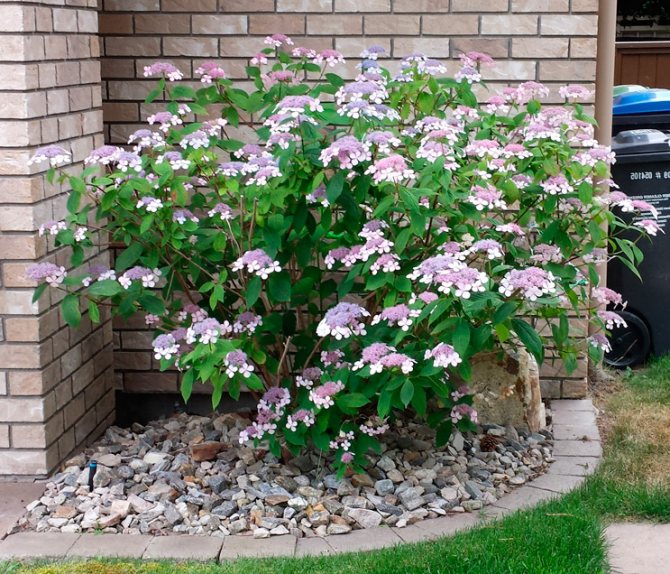

The serrated hydrangea has a very unusual appearance.
Today there are many varieties of shrubs, including hybrid ones. They are available for planting to everyone.
Video
Pruning
Hydrangea serrated Bluebird needs pruning. It is advisable to carry out this procedure in the fall. In the spring and summer, shrubs are pruned, which need to be given a splendor or a certain shape.
Pruning happens:
- strong - they leave branches with two to three buds, while getting large inflorescences, but there will be much less of them;
- weak - only the tops of the shoots are cut into two or three buds, many inflorescences will form, but they will be small;
- rejuvenating - carried out once every 2-3 years by cutting the bush to the base of the stem branches.
Additional Information
Bluebird serrate hydrangea (described below) is widespread in Japan. In this country, flowers are used for landscaping and landscaping, as well as for decorating gardens and park areas. Bushes can grow up to one meter or more in height, and the width of their crown often exceeds one and a half meters, which is why they resemble large green balls.
Many gardeners liked this variety with its bright shades of buds, decorative appearance and ease of care. Bluebird serrated hydrangea is unpretentious, so it adapts well to almost any climatic conditions on various types of soils. The inflorescences of this variety are truly unique.
In the center are small buds, which can be pink or bright red with blue stamens, and along the edges there are flowers reaching a diameter of three centimeters. At the same time, it is noteworthy that the color of the petals can change depending on the level of acidity of the soil, which is often used when registering a land plot.
Check out other materials on garden hydrangea:
- How to properly care for Bobo panicle hydrangea? Growing and preparing for winter
- How to properly care for my Limelight hydrangea?
- How does Oakleaf hydrangea winter?
- Frost-resistant hydrangea Pinky Winky on your site
- Hydrangea paniculata grandiflora - features of care and reproduction in the garden
- Frost-resistant hydrangea large-leaved
- Climbing hydrangea (petiolate, climbing) is a hedge in your garden!
- Hydrangea tree annabelle - a snow-white decoration of your site
- Tree hydrangea in your garden - planting and care, reproduction, wintering
- Japanese hydrangea Kyushu in your garden
Grows up to 2 meters
Hydrangea oakleaf:
- About the grade. An ornamental shrub that can beautify any garden. The homeland of the plant is North America. Equally beautiful hydrangea, both during flowering and growing. It reaches a height of 2 m, the main characteristic is the 7-lobed leaves similar to oak.
- About flowers. Inflorescences resemble panicles with sterile large flowers. The shrub blooms from June to September in white. It grows quickly, retains peduncles for a long time.
- About leaving. Prefers rich soil, abundant watering and sunny places. The plant is winter-hardy, but due to the branched root system it does not tolerate snowless winters and needs additional shelter.
Video:
The history of the emergence of hydrangea
Oak-leaved hydrangea was brought to Europe from South and East Asia for the wealthy strata of society at the beginning of the 14th century, to Russia - around the 19th and 20th centuries. Initially, there were 2 types: white and red hydrangeas.
The name of the plant was given by Philibert Commerson. In that era, the word "hydrangea" was considered a common female name. Many theories have arisen as to who the plant was dedicated to.
Reference. European botanists gave the hydrangea a scientific name - Hydrangea, which can be translated as "a vessel with water." In Japan it is called ajisai.
Legend of origin
One clear day, the girl was sitting by the cleanest lake. Suddenly, raising her gaze, the maiden saw a handsome prince from a neighboring tribe. The young man smiled at her, and the girl realized that her heart would never be able to beat before.
The days flew by, the day was approaching when the girl had to return to her native land. At the same time, their love grew stronger ... The parting was difficult. Many said that the tears of the maiden were like drops of blood.
In the place where the tears of the lovers soaked the earth, a large white flowering hydrangea bush appeared. He was as big, powerful, strong as an oak tree.
To this day, this plant personifies deep, strong, but unhappy love.
Oak-leaved hydrangea wintering
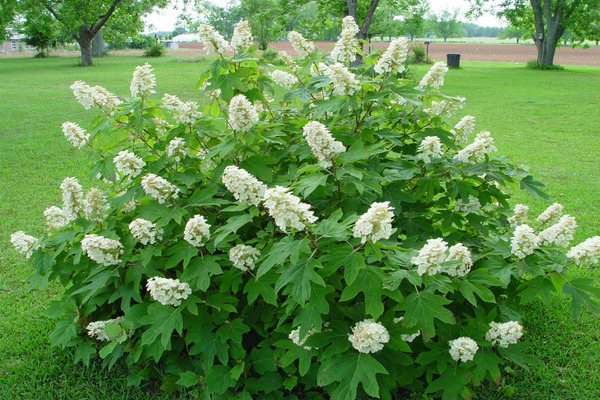

For this plant, competent wintering is simply necessary, this is especially important for a young hydrangea. A young seedling is transplanted into a pot container and kept in a heated room. Mid-December is the time when the hydrangea, having lost its foliage, falls asleep. That is why it should be placed in a dark place and watering should be reduced.
By the time the plant wakes up (April), bud swelling can be observed. Right now, the plant needs to be put to the window, into the light. Irrigation with fertilizers is gradually introduced. And closer to May, the hydrangea is planted in open soil in the garden.
In the south and west of Russia, oak-leaved hydrangea will easily survive the winter, it does not have to be transplanted into a pot and cleaned indoors. But, a winter shelter is necessary for her. The plant is covered in autumn (October-November). To do this, bending the branches to the soil, cover the hydrangea with a covering material.
In the spring, the plant is gradually freed from the shelter. Pay close attention to the weather forecast so as not to miss sharp frosts. After passing all the dangers, you can fully open the plant.
Oakleaf hydrangea planting and care
Among newcomers, a false statement is common about the capriciousness of the oak-leaved hydrangea. But this is not at all the case. With a competent approach, complex care is not required.
The plant is planted in open soil in the spring. The prepared hole should be partially filled with fertile soil (red peat, pine litter are suitable).
The plant is placed at a shallow depth and the roots are covered with soil. The soil is compacted and watered. For some time, the seedling will take root, and it will need to provide a shady place and water it well.
Be sure to take soil quality seriously before planting. The soil must not contain lime. The soil needs to be loose, fertile, well-drained and acidified.
The soil is acidified every two weeks with the help of fertilizers to achieve a pH level of about 4.5-6.5. The soil must be regularly moistened (there should not be any drying out!). This problem can be easily solved by using annual mulching in your arsenal for caring for oaky hydrangea. Watering should be warm, water consumption - three buckets per bush.
We figured out the composition of the soil, now it's worth going to the planting site. This is the most important stage. Firstly, hydrangea does not like the scorching rays of the sun. For her, a great place will be - the shade, and this will not affect the flowering of the culture in any way. Temperature drops for her are not a problem, but nevertheless, be careful with hypothermia (such as, for example, spring frosts).
It's time to talk about feeding for hydrangeas. For active growth and lush flowering, organic and mineral fertilizers with iron and magnesium are needed. Complex fertilizers should be applied during the planting period and throughout the subsequent season, that is, twice a year. So, the time for complex mineral fertilizers in the form of superphosphate, urea, potash sulfur - the horses of spring - early summer. And further, you need top dressing 2 times a month until mid-summer. As a result, feeding is stopped in the month of July in order for the plant to become woody before winter.
Do not bust with fertilizer, otherwise it can lead to fragility of the branches due to large and heavy inflorescences.
Now about the propagation of hydrangeas: there are several ways - cuttings, dividing bushes, seeds and grafting.
- Cutting is best done in mid-summer when the plant is in bloom. It takes root within a month, this requires shade and moderate summer temperatures (up to 20 degrees).It is important to remember that cuttings of lignified shoots are not carried out: they are not suitable for these purposes.
- The division of the bushes is carried out in the spring or in the fall. For these purposes, the plant is dug out of the ground and divided into parts, leaving several buds on each, from which new shoots will soon appear.
- Reproduction of oak-leaved hydrangea by seeds is not an easy task. It is difficult, but possible. For this purpose, sowing boxes are first prepared, where peat, sand, humus are placed. Sow and regularly watered with a spray bottle. Spring sowing brings seedlings in 30 days, while in autumn the plants will reach a height of up to half a meter.
Pruning is done in the spring before fresh foliage blooms. The plant is eliminated from weak, damaged branches, and in powerful ones, 4-6 buds are left. On summer days, they get rid of drying inflorescences, which will allow the young to gain strength.
Choosing a place for planting and preparing the soil
To plant a plant, partial shade is required. Direct sunlight can hit the crop only in the morning and evening. In this case, strong shading of the culture should be avoided.
Hydrangea develops normally in acidic or slightly acidic soil. If the soil is neutral, peat is added to it. Alkaline soil types will not work for the plant.
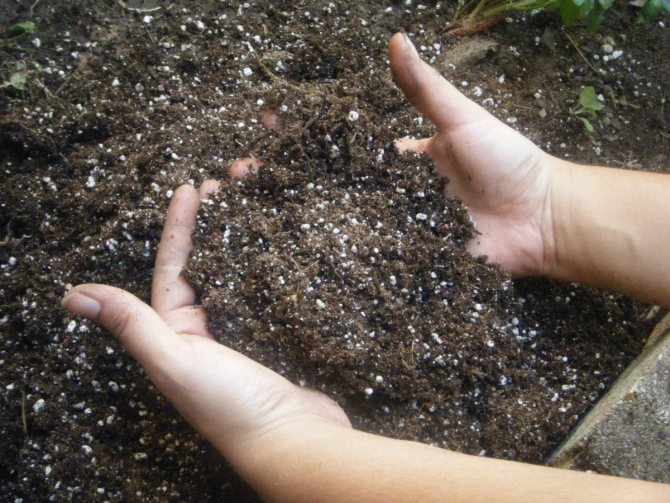

Hydrangea loves acidic soil

